Literature Review: Dividends & Franking Credits Market Value
VerifiedAdded on 2023/06/03
|10
|2077
|186
Literature Review
AI Summary
This literature review examines the market value of dividends and franking credits within the Australian context. It begins by outlining the background of franking credits, including their role in mitigating double taxation of corporate income and the eligibility requirements for investors. The review then discusses the Australian dividend imputation system, highlighting its impact on both investors and companies, and contrasting it with the classical tax system. It also addresses the accumulation of undistributed franking credits and their implications for finance theory. Furthermore, the review delves into methods for estimating the market value of franking credits, particularly the Gamma method within the Weighted Average Cost of Capital framework, and explores how stock market prices react to dividend and franking credit distributions. The review concludes that while the effectiveness of imputation on share prices and the cost of capital remains debated, it likely has varied effects, particularly for smaller, domestic corporations, and has influenced behaviors such as dividend payouts and domestic investment tendencies.

LITERATURE REVIEW ON MARKET VALUE OF
DIVIDEND AND FRANKING CREDIT IN AUSTRALIA
DIVIDEND AND FRANKING CREDIT IN AUSTRALIA
Paraphrase This Document
Need a fresh take? Get an instant paraphrase of this document with our AI Paraphraser
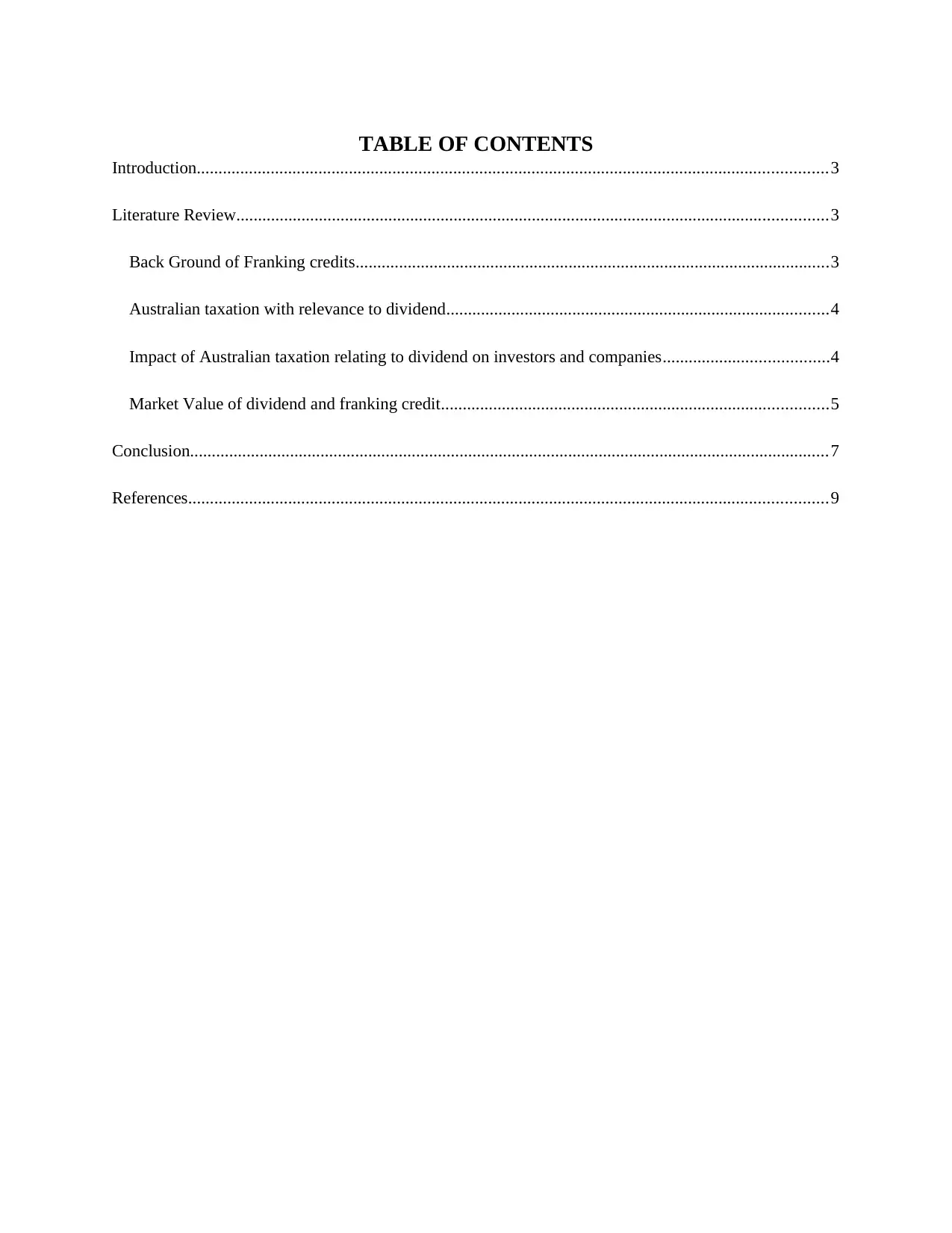
TABLE OF CONTENTS
Introduction.................................................................................................................................................3
Literature Review........................................................................................................................................3
Back Ground of Franking credits.............................................................................................................3
Australian taxation with relevance to dividend........................................................................................4
Impact of Australian taxation relating to dividend on investors and companies......................................4
Market Value of dividend and franking credit.........................................................................................5
Conclusion...................................................................................................................................................7
References...................................................................................................................................................9
Introduction.................................................................................................................................................3
Literature Review........................................................................................................................................3
Back Ground of Franking credits.............................................................................................................3
Australian taxation with relevance to dividend........................................................................................4
Impact of Australian taxation relating to dividend on investors and companies......................................4
Market Value of dividend and franking credit.........................................................................................5
Conclusion...................................................................................................................................................7
References...................................................................................................................................................9
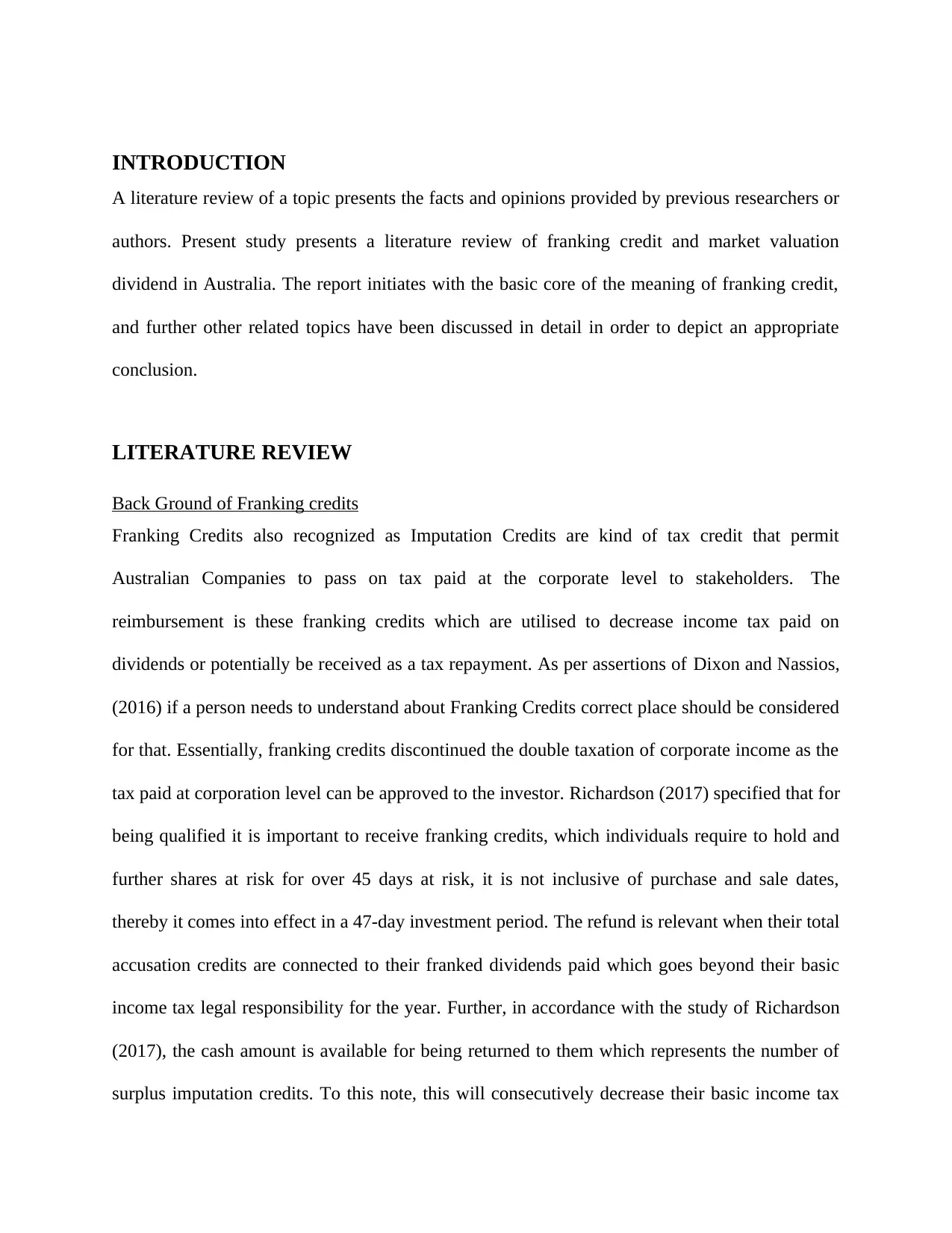
INTRODUCTION
A literature review of a topic presents the facts and opinions provided by previous researchers or
authors. Present study presents a literature review of franking credit and market valuation
dividend in Australia. The report initiates with the basic core of the meaning of franking credit,
and further other related topics have been discussed in detail in order to depict an appropriate
conclusion.
LITERATURE REVIEW
Back Ground of Franking credits
Franking Credits also recognized as Imputation Credits are kind of tax credit that permit
Australian Companies to pass on tax paid at the corporate level to stakeholders. The
reimbursement is these franking credits which are utilised to decrease income tax paid on
dividends or potentially be received as a tax repayment. As per assertions of Dixon and Nassios,
(2016) if a person needs to understand about Franking Credits correct place should be considered
for that. Essentially, franking credits discontinued the double taxation of corporate income as the
tax paid at corporation level can be approved to the investor. Richardson (2017) specified that for
being qualified it is important to receive franking credits, which individuals require to hold and
further shares at risk for over 45 days at risk, it is not inclusive of purchase and sale dates,
thereby it comes into effect in a 47-day investment period. The refund is relevant when their total
accusation credits are connected to their franked dividends paid which goes beyond their basic
income tax legal responsibility for the year. Further, in accordance with the study of Richardson
(2017), the cash amount is available for being returned to them which represents the number of
surplus imputation credits. To this note, this will consecutively decrease their basic income tax
A literature review of a topic presents the facts and opinions provided by previous researchers or
authors. Present study presents a literature review of franking credit and market valuation
dividend in Australia. The report initiates with the basic core of the meaning of franking credit,
and further other related topics have been discussed in detail in order to depict an appropriate
conclusion.
LITERATURE REVIEW
Back Ground of Franking credits
Franking Credits also recognized as Imputation Credits are kind of tax credit that permit
Australian Companies to pass on tax paid at the corporate level to stakeholders. The
reimbursement is these franking credits which are utilised to decrease income tax paid on
dividends or potentially be received as a tax repayment. As per assertions of Dixon and Nassios,
(2016) if a person needs to understand about Franking Credits correct place should be considered
for that. Essentially, franking credits discontinued the double taxation of corporate income as the
tax paid at corporation level can be approved to the investor. Richardson (2017) specified that for
being qualified it is important to receive franking credits, which individuals require to hold and
further shares at risk for over 45 days at risk, it is not inclusive of purchase and sale dates,
thereby it comes into effect in a 47-day investment period. The refund is relevant when their total
accusation credits are connected to their franked dividends paid which goes beyond their basic
income tax legal responsibility for the year. Further, in accordance with the study of Richardson
(2017), the cash amount is available for being returned to them which represents the number of
surplus imputation credits. To this note, this will consecutively decrease their basic income tax
⊘ This is a preview!⊘
Do you want full access?
Subscribe today to unlock all pages.

Trusted by 1+ million students worldwide
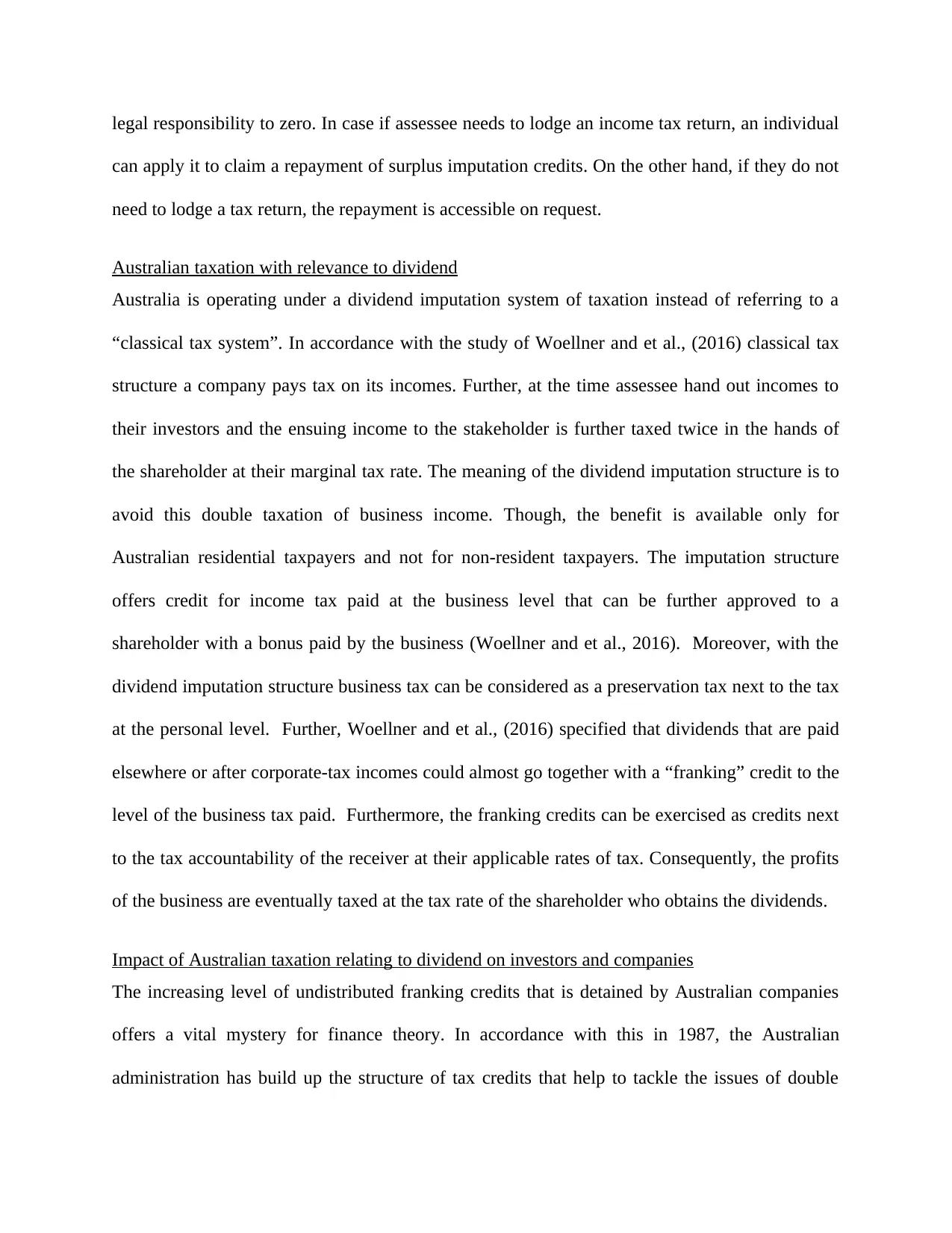
legal responsibility to zero. In case if assessee needs to lodge an income tax return, an individual
can apply it to claim a repayment of surplus imputation credits. On the other hand, if they do not
need to lodge a tax return, the repayment is accessible on request.
Australian taxation with relevance to dividend
Australia is operating under a dividend imputation system of taxation instead of referring to a
“classical tax system”. In accordance with the study of Woellner and et al., (2016) classical tax
structure a company pays tax on its incomes. Further, at the time assessee hand out incomes to
their investors and the ensuing income to the stakeholder is further taxed twice in the hands of
the shareholder at their marginal tax rate. The meaning of the dividend imputation structure is to
avoid this double taxation of business income. Though, the benefit is available only for
Australian residential taxpayers and not for non-resident taxpayers. The imputation structure
offers credit for income tax paid at the business level that can be further approved to a
shareholder with a bonus paid by the business (Woellner and et al., 2016). Moreover, with the
dividend imputation structure business tax can be considered as a preservation tax next to the tax
at the personal level. Further, Woellner and et al., (2016) specified that dividends that are paid
elsewhere or after corporate-tax incomes could almost go together with a “franking” credit to the
level of the business tax paid. Furthermore, the franking credits can be exercised as credits next
to the tax accountability of the receiver at their applicable rates of tax. Consequently, the profits
of the business are eventually taxed at the tax rate of the shareholder who obtains the dividends.
Impact of Australian taxation relating to dividend on investors and companies
The increasing level of undistributed franking credits that is detained by Australian companies
offers a vital mystery for finance theory. In accordance with this in 1987, the Australian
administration has build up the structure of tax credits that help to tackle the issues of double
can apply it to claim a repayment of surplus imputation credits. On the other hand, if they do not
need to lodge a tax return, the repayment is accessible on request.
Australian taxation with relevance to dividend
Australia is operating under a dividend imputation system of taxation instead of referring to a
“classical tax system”. In accordance with the study of Woellner and et al., (2016) classical tax
structure a company pays tax on its incomes. Further, at the time assessee hand out incomes to
their investors and the ensuing income to the stakeholder is further taxed twice in the hands of
the shareholder at their marginal tax rate. The meaning of the dividend imputation structure is to
avoid this double taxation of business income. Though, the benefit is available only for
Australian residential taxpayers and not for non-resident taxpayers. The imputation structure
offers credit for income tax paid at the business level that can be further approved to a
shareholder with a bonus paid by the business (Woellner and et al., 2016). Moreover, with the
dividend imputation structure business tax can be considered as a preservation tax next to the tax
at the personal level. Further, Woellner and et al., (2016) specified that dividends that are paid
elsewhere or after corporate-tax incomes could almost go together with a “franking” credit to the
level of the business tax paid. Furthermore, the franking credits can be exercised as credits next
to the tax accountability of the receiver at their applicable rates of tax. Consequently, the profits
of the business are eventually taxed at the tax rate of the shareholder who obtains the dividends.
Impact of Australian taxation relating to dividend on investors and companies
The increasing level of undistributed franking credits that is detained by Australian companies
offers a vital mystery for finance theory. In accordance with this in 1987, the Australian
administration has build up the structure of tax credits that help to tackle the issues of double
Paraphrase This Document
Need a fresh take? Get an instant paraphrase of this document with our AI Paraphraser
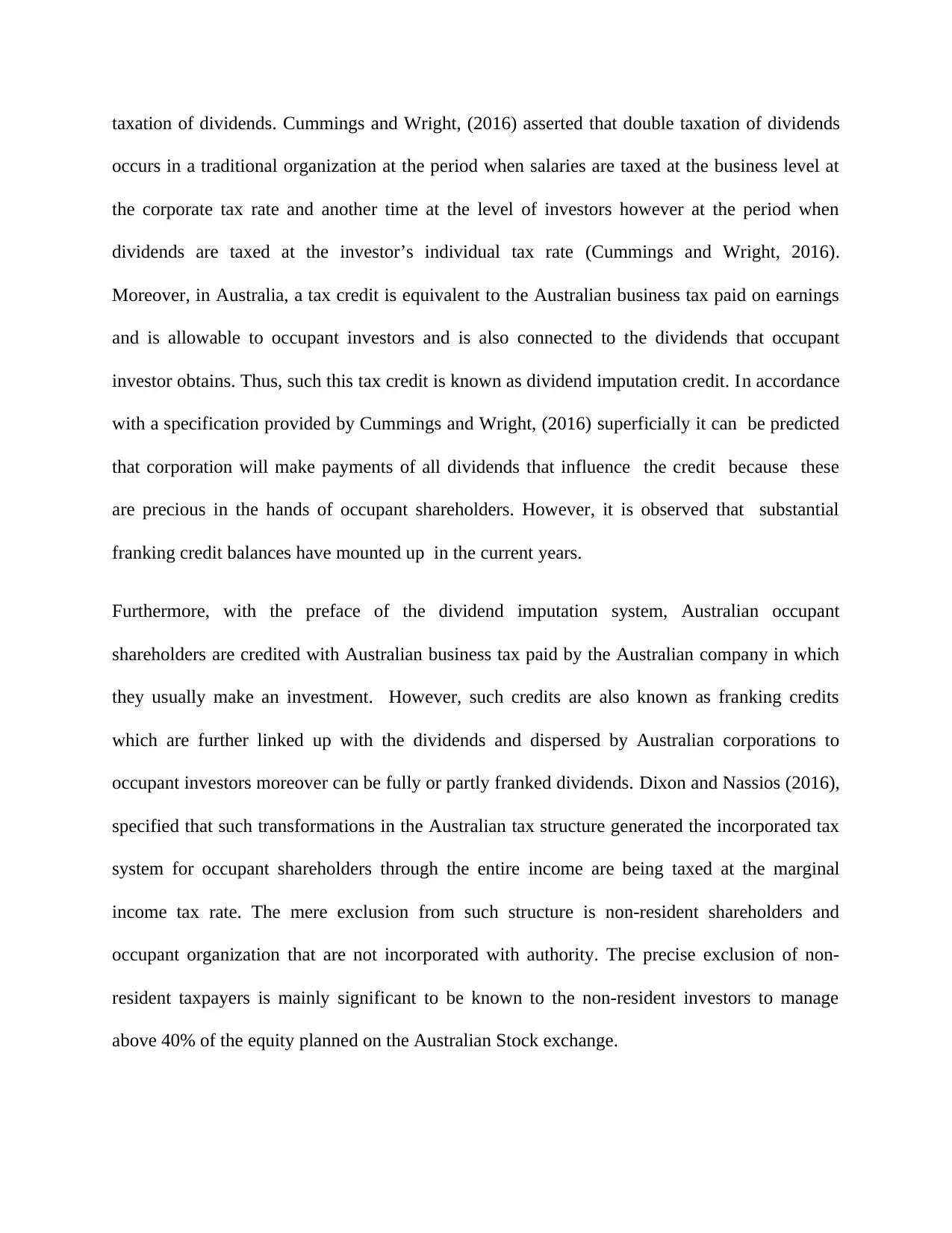
taxation of dividends. Cummings and Wright, (2016) asserted that double taxation of dividends
occurs in a traditional organization at the period when salaries are taxed at the business level at
the corporate tax rate and another time at the level of investors however at the period when
dividends are taxed at the investor’s individual tax rate (Cummings and Wright, 2016).
Moreover, in Australia, a tax credit is equivalent to the Australian business tax paid on earnings
and is allowable to occupant investors and is also connected to the dividends that occupant
investor obtains. Thus, such this tax credit is known as dividend imputation credit. In accordance
with a specification provided by Cummings and Wright, (2016) superficially it can be predicted
that corporation will make payments of all dividends that influence the credit because these
are precious in the hands of occupant shareholders. However, it is observed that substantial
franking credit balances have mounted up in the current years.
Furthermore, with the preface of the dividend imputation system, Australian occupant
shareholders are credited with Australian business tax paid by the Australian company in which
they usually make an investment. However, such credits are also known as franking credits
which are further linked up with the dividends and dispersed by Australian corporations to
occupant investors moreover can be fully or partly franked dividends. Dixon and Nassios (2016),
specified that such transformations in the Australian tax structure generated the incorporated tax
system for occupant shareholders through the entire income are being taxed at the marginal
income tax rate. The mere exclusion from such structure is non-resident shareholders and
occupant organization that are not incorporated with authority. The precise exclusion of non-
resident taxpayers is mainly significant to be known to the non-resident investors to manage
above 40% of the equity planned on the Australian Stock exchange.
occurs in a traditional organization at the period when salaries are taxed at the business level at
the corporate tax rate and another time at the level of investors however at the period when
dividends are taxed at the investor’s individual tax rate (Cummings and Wright, 2016).
Moreover, in Australia, a tax credit is equivalent to the Australian business tax paid on earnings
and is allowable to occupant investors and is also connected to the dividends that occupant
investor obtains. Thus, such this tax credit is known as dividend imputation credit. In accordance
with a specification provided by Cummings and Wright, (2016) superficially it can be predicted
that corporation will make payments of all dividends that influence the credit because these
are precious in the hands of occupant shareholders. However, it is observed that substantial
franking credit balances have mounted up in the current years.
Furthermore, with the preface of the dividend imputation system, Australian occupant
shareholders are credited with Australian business tax paid by the Australian company in which
they usually make an investment. However, such credits are also known as franking credits
which are further linked up with the dividends and dispersed by Australian corporations to
occupant investors moreover can be fully or partly franked dividends. Dixon and Nassios (2016),
specified that such transformations in the Australian tax structure generated the incorporated tax
system for occupant shareholders through the entire income are being taxed at the marginal
income tax rate. The mere exclusion from such structure is non-resident shareholders and
occupant organization that are not incorporated with authority. The precise exclusion of non-
resident taxpayers is mainly significant to be known to the non-resident investors to manage
above 40% of the equity planned on the Australian Stock exchange.
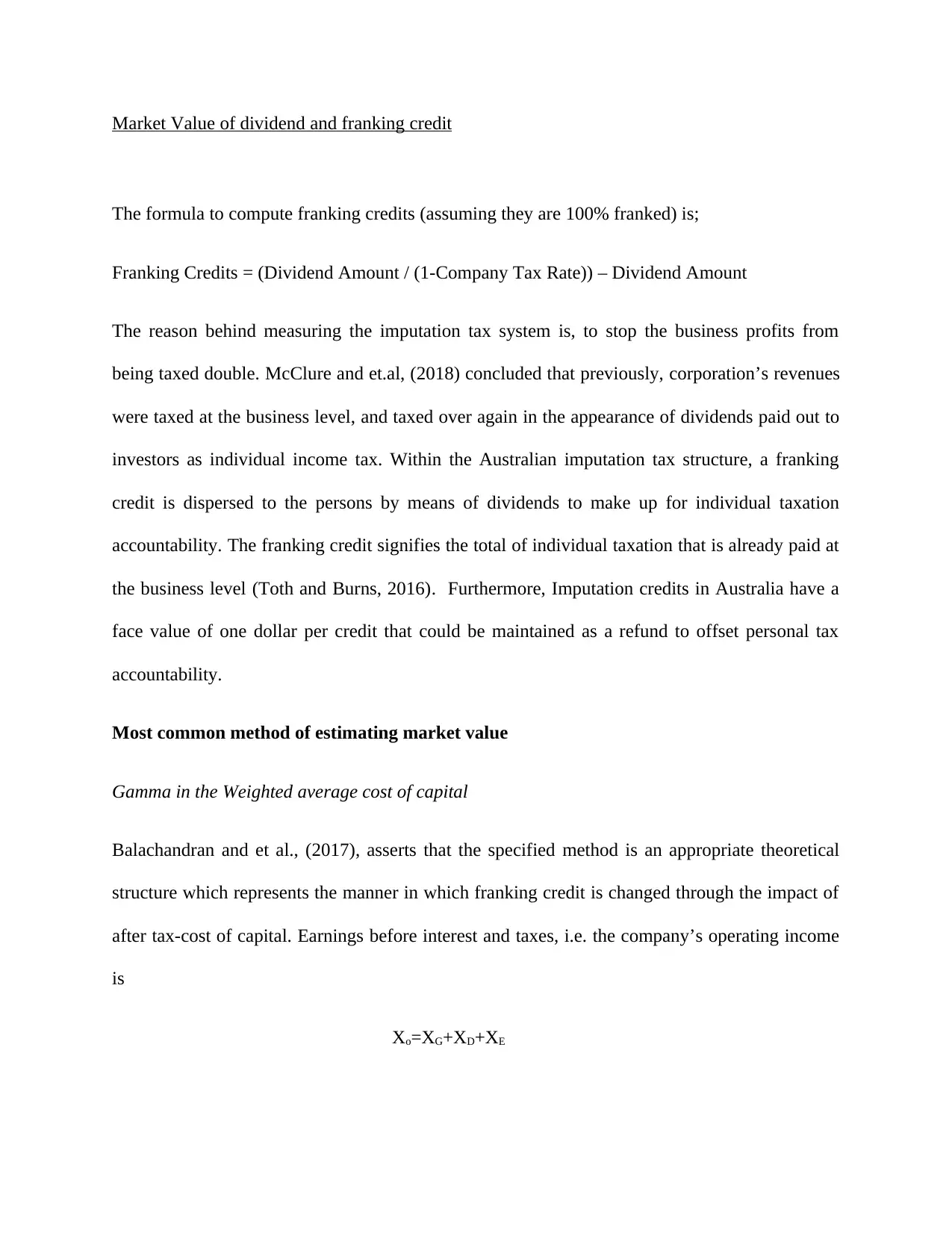
Market Value of dividend and franking credit
The formula to compute franking credits (assuming they are 100% franked) is;
Franking Credits = (Dividend Amount / (1-Company Tax Rate)) – Dividend Amount
The reason behind measuring the imputation tax system is, to stop the business profits from
being taxed double. McClure and et.al, (2018) concluded that previously, corporation’s revenues
were taxed at the business level, and taxed over again in the appearance of dividends paid out to
investors as individual income tax. Within the Australian imputation tax structure, a franking
credit is dispersed to the persons by means of dividends to make up for individual taxation
accountability. The franking credit signifies the total of individual taxation that is already paid at
the business level (Toth and Burns, 2016). Furthermore, Imputation credits in Australia have a
face value of one dollar per credit that could be maintained as a refund to offset personal tax
accountability.
Most common method of estimating market value
Gamma in the Weighted average cost of capital
Balachandran and et al., (2017), asserts that the specified method is an appropriate theoretical
structure which represents the manner in which franking credit is changed through the impact of
after tax-cost of capital. Earnings before interest and taxes, i.e. the company’s operating income
is
Xo=XG+XD+XE
The formula to compute franking credits (assuming they are 100% franked) is;
Franking Credits = (Dividend Amount / (1-Company Tax Rate)) – Dividend Amount
The reason behind measuring the imputation tax system is, to stop the business profits from
being taxed double. McClure and et.al, (2018) concluded that previously, corporation’s revenues
were taxed at the business level, and taxed over again in the appearance of dividends paid out to
investors as individual income tax. Within the Australian imputation tax structure, a franking
credit is dispersed to the persons by means of dividends to make up for individual taxation
accountability. The franking credit signifies the total of individual taxation that is already paid at
the business level (Toth and Burns, 2016). Furthermore, Imputation credits in Australia have a
face value of one dollar per credit that could be maintained as a refund to offset personal tax
accountability.
Most common method of estimating market value
Gamma in the Weighted average cost of capital
Balachandran and et al., (2017), asserts that the specified method is an appropriate theoretical
structure which represents the manner in which franking credit is changed through the impact of
after tax-cost of capital. Earnings before interest and taxes, i.e. the company’s operating income
is
Xo=XG+XD+XE
⊘ This is a preview!⊘
Do you want full access?
Subscribe today to unlock all pages.

Trusted by 1+ million students worldwide
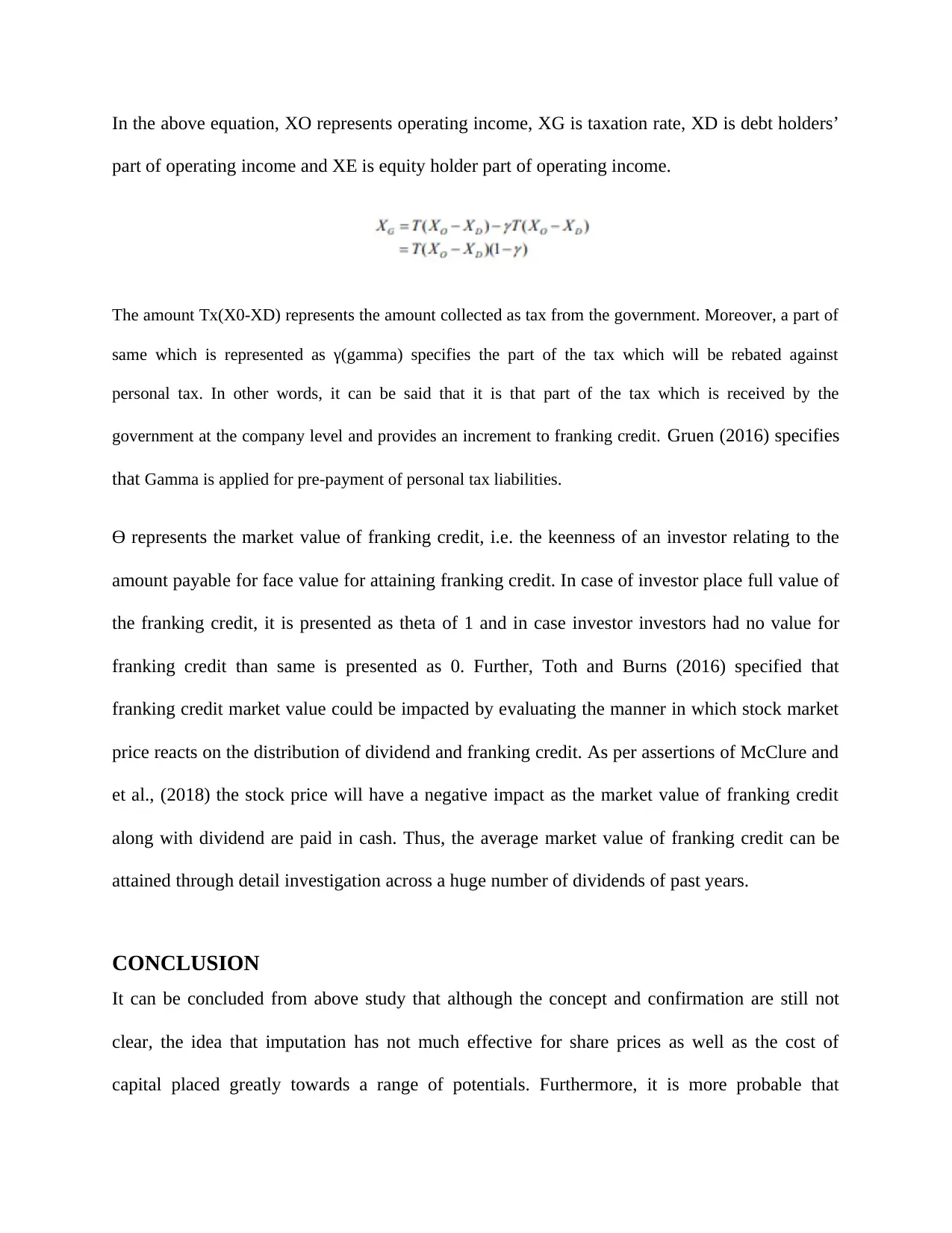
In the above equation, XO represents operating income, XG is taxation rate, XD is debt holders’
part of operating income and XE is equity holder part of operating income.
The amount Tx(X0-XD) represents the amount collected as tax from the government. Moreover, a part of
same which is represented as γ(gamma) specifies the part of the tax which will be rebated against
personal tax. In other words, it can be said that it is that part of the tax which is received by the
government at the company level and provides an increment to franking credit. Gruen (2016) specifies
that Gamma is applied for pre-payment of personal tax liabilities.
Ɵ represents the market value of franking credit, i.e. the keenness of an investor relating to the
amount payable for face value for attaining franking credit. In case of investor place full value of
the franking credit, it is presented as theta of 1 and in case investor investors had no value for
franking credit than same is presented as 0. Further, Toth and Burns (2016) specified that
franking credit market value could be impacted by evaluating the manner in which stock market
price reacts on the distribution of dividend and franking credit. As per assertions of McClure and
et al., (2018) the stock price will have a negative impact as the market value of franking credit
along with dividend are paid in cash. Thus, the average market value of franking credit can be
attained through detail investigation across a huge number of dividends of past years.
CONCLUSION
It can be concluded from above study that although the concept and confirmation are still not
clear, the idea that imputation has not much effective for share prices as well as the cost of
capital placed greatly towards a range of potentials. Furthermore, it is more probable that
part of operating income and XE is equity holder part of operating income.
The amount Tx(X0-XD) represents the amount collected as tax from the government. Moreover, a part of
same which is represented as γ(gamma) specifies the part of the tax which will be rebated against
personal tax. In other words, it can be said that it is that part of the tax which is received by the
government at the company level and provides an increment to franking credit. Gruen (2016) specifies
that Gamma is applied for pre-payment of personal tax liabilities.
Ɵ represents the market value of franking credit, i.e. the keenness of an investor relating to the
amount payable for face value for attaining franking credit. In case of investor place full value of
the franking credit, it is presented as theta of 1 and in case investor investors had no value for
franking credit than same is presented as 0. Further, Toth and Burns (2016) specified that
franking credit market value could be impacted by evaluating the manner in which stock market
price reacts on the distribution of dividend and franking credit. As per assertions of McClure and
et al., (2018) the stock price will have a negative impact as the market value of franking credit
along with dividend are paid in cash. Thus, the average market value of franking credit can be
attained through detail investigation across a huge number of dividends of past years.
CONCLUSION
It can be concluded from above study that although the concept and confirmation are still not
clear, the idea that imputation has not much effective for share prices as well as the cost of
capital placed greatly towards a range of potentials. Furthermore, it is more probable that
Paraphrase This Document
Need a fresh take? Get an instant paraphrase of this document with our AI Paraphraser
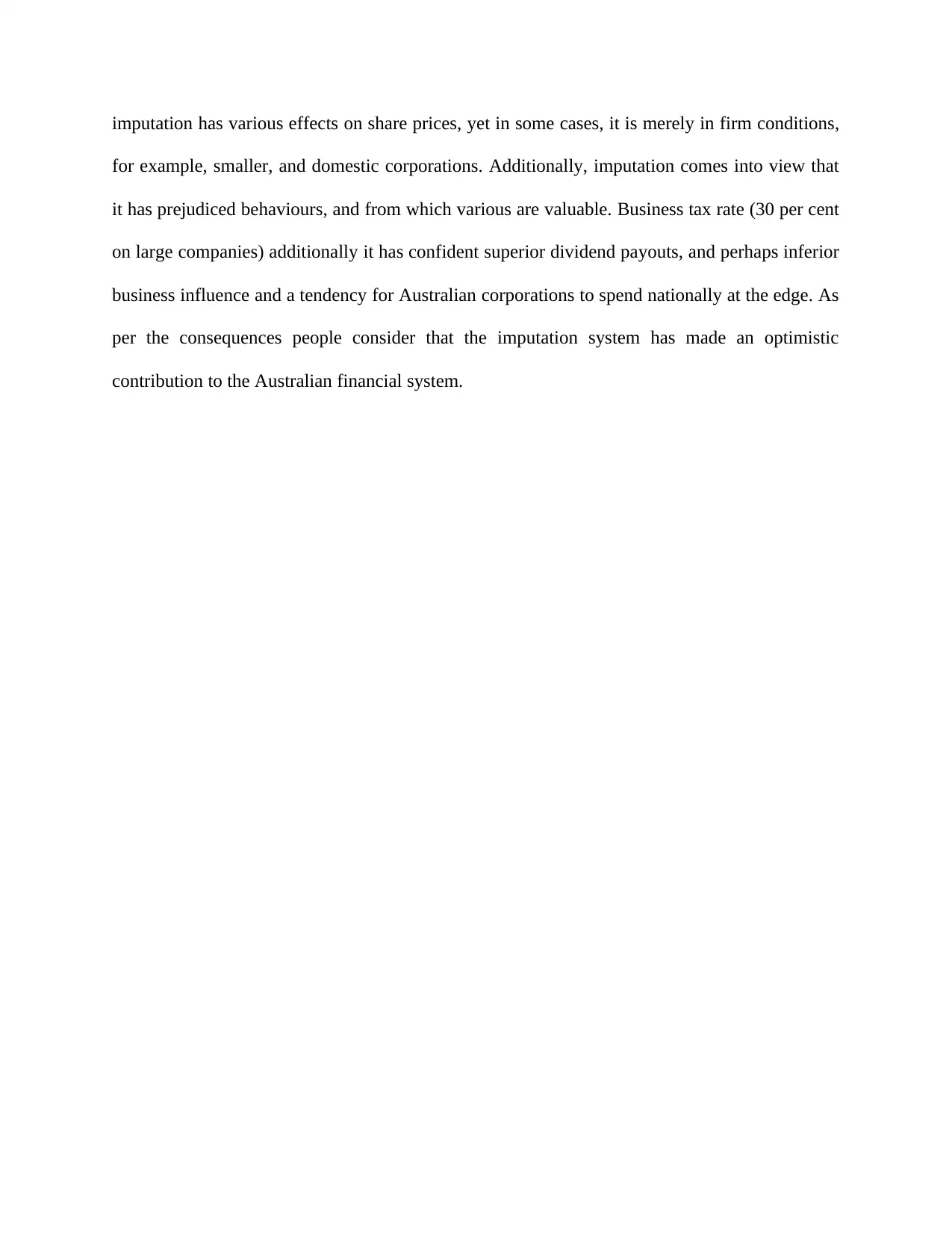
imputation has various effects on share prices, yet in some cases, it is merely in firm conditions,
for example, smaller, and domestic corporations. Additionally, imputation comes into view that
it has prejudiced behaviours, and from which various are valuable. Business tax rate (30 per cent
on large companies) additionally it has confident superior dividend payouts, and perhaps inferior
business influence and a tendency for Australian corporations to spend nationally at the edge. As
per the consequences people consider that the imputation system has made an optimistic
contribution to the Australian financial system.
for example, smaller, and domestic corporations. Additionally, imputation comes into view that
it has prejudiced behaviours, and from which various are valuable. Business tax rate (30 per cent
on large companies) additionally it has confident superior dividend payouts, and perhaps inferior
business influence and a tendency for Australian corporations to spend nationally at the edge. As
per the consequences people consider that the imputation system has made an optimistic
contribution to the Australian financial system.
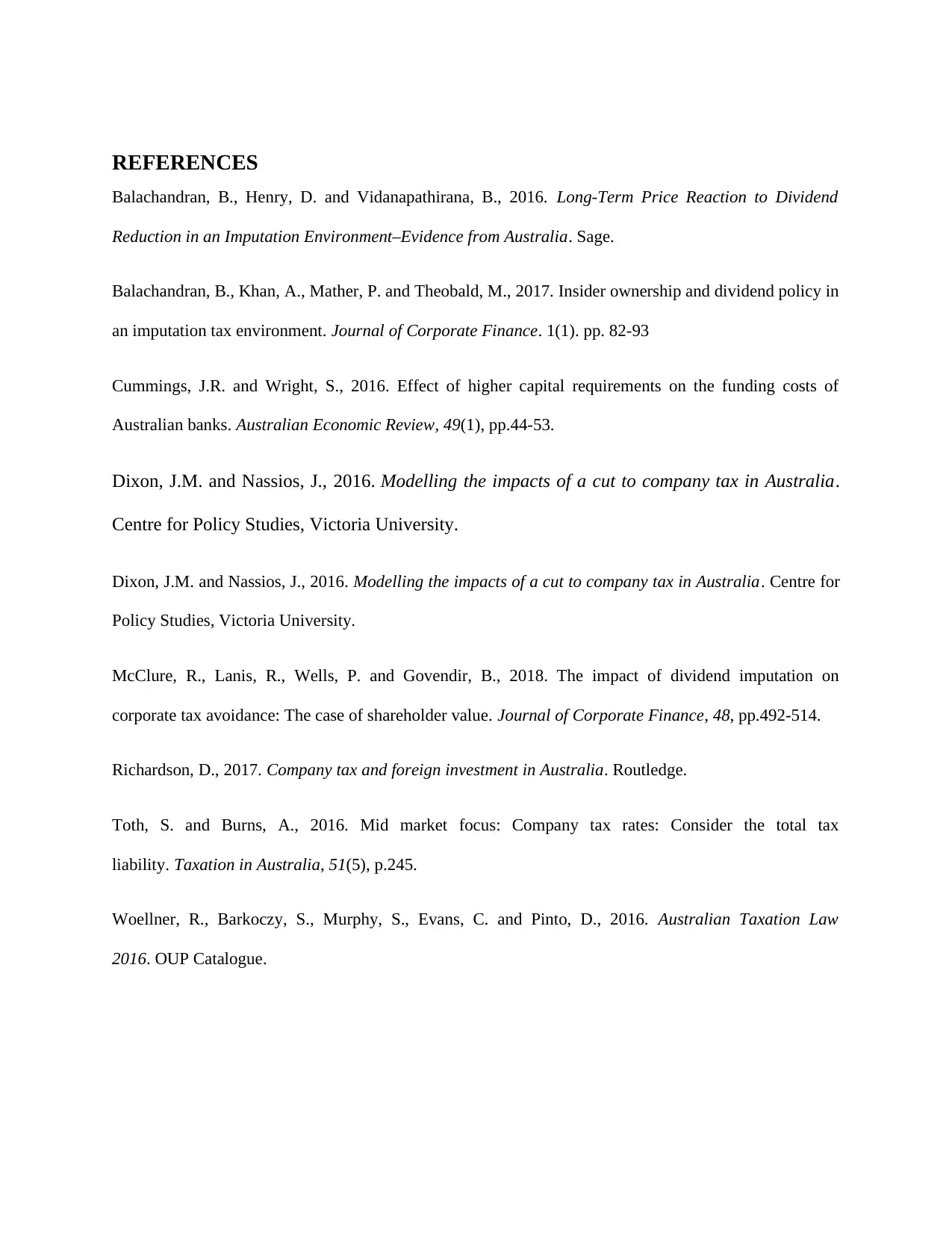
REFERENCES
Balachandran, B., Henry, D. and Vidanapathirana, B., 2016. Long-Term Price Reaction to Dividend
Reduction in an Imputation Environment–Evidence from Australia. Sage.
Balachandran, B., Khan, A., Mather, P. and Theobald, M., 2017. Insider ownership and dividend policy in
an imputation tax environment. Journal of Corporate Finance. 1(1). pp. 82-93
Cummings, J.R. and Wright, S., 2016. Effect of higher capital requirements on the funding costs of
Australian banks. Australian Economic Review, 49(1), pp.44-53.
Dixon, J.M. and Nassios, J., 2016. Modelling the impacts of a cut to company tax in Australia.
Centre for Policy Studies, Victoria University.
Dixon, J.M. and Nassios, J., 2016. Modelling the impacts of a cut to company tax in Australia. Centre for
Policy Studies, Victoria University.
McClure, R., Lanis, R., Wells, P. and Govendir, B., 2018. The impact of dividend imputation on
corporate tax avoidance: The case of shareholder value. Journal of Corporate Finance, 48, pp.492-514.
Richardson, D., 2017. Company tax and foreign investment in Australia. Routledge.
Toth, S. and Burns, A., 2016. Mid market focus: Company tax rates: Consider the total tax
liability. Taxation in Australia, 51(5), p.245.
Woellner, R., Barkoczy, S., Murphy, S., Evans, C. and Pinto, D., 2016. Australian Taxation Law
2016. OUP Catalogue.
Balachandran, B., Henry, D. and Vidanapathirana, B., 2016. Long-Term Price Reaction to Dividend
Reduction in an Imputation Environment–Evidence from Australia. Sage.
Balachandran, B., Khan, A., Mather, P. and Theobald, M., 2017. Insider ownership and dividend policy in
an imputation tax environment. Journal of Corporate Finance. 1(1). pp. 82-93
Cummings, J.R. and Wright, S., 2016. Effect of higher capital requirements on the funding costs of
Australian banks. Australian Economic Review, 49(1), pp.44-53.
Dixon, J.M. and Nassios, J., 2016. Modelling the impacts of a cut to company tax in Australia.
Centre for Policy Studies, Victoria University.
Dixon, J.M. and Nassios, J., 2016. Modelling the impacts of a cut to company tax in Australia. Centre for
Policy Studies, Victoria University.
McClure, R., Lanis, R., Wells, P. and Govendir, B., 2018. The impact of dividend imputation on
corporate tax avoidance: The case of shareholder value. Journal of Corporate Finance, 48, pp.492-514.
Richardson, D., 2017. Company tax and foreign investment in Australia. Routledge.
Toth, S. and Burns, A., 2016. Mid market focus: Company tax rates: Consider the total tax
liability. Taxation in Australia, 51(5), p.245.
Woellner, R., Barkoczy, S., Murphy, S., Evans, C. and Pinto, D., 2016. Australian Taxation Law
2016. OUP Catalogue.
⊘ This is a preview!⊘
Do you want full access?
Subscribe today to unlock all pages.

Trusted by 1+ million students worldwide

1 out of 10
Related Documents
Your All-in-One AI-Powered Toolkit for Academic Success.
+13062052269
info@desklib.com
Available 24*7 on WhatsApp / Email
![[object Object]](/_next/static/media/star-bottom.7253800d.svg)
Unlock your academic potential
Copyright © 2020–2025 A2Z Services. All Rights Reserved. Developed and managed by ZUCOL.





